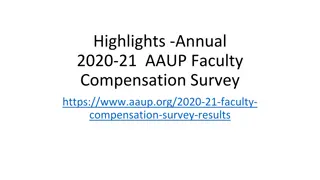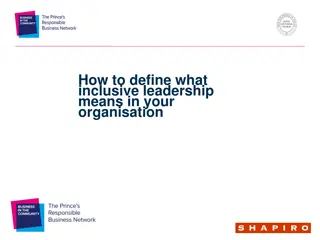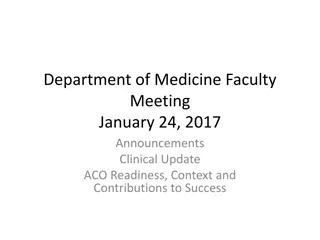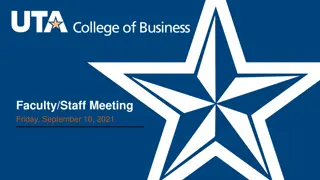Enhancing Inclusive Teaching Practices: Faculty Workshop Insights
Explore the importance of inclusive teaching through the perspectives shared by Dr. Bronkema, Dr. DiPietro, Dr. Etheridge, Dr. Grissett, and Dr. Landau. Dive into learning objectives focusing on experiencing inclusion and exclusion, understanding the impact of course climate on learning, and the dynamics of inclusion in teaching and learning processes. Delve into strategies to know yourself, understand your students, and enhance teaching methods for inclusivity.
Download Presentation

Please find below an Image/Link to download the presentation.
The content on the website is provided AS IS for your information and personal use only. It may not be sold, licensed, or shared on other websites without obtaining consent from the author. Download presentation by click this link. If you encounter any issues during the download, it is possible that the publisher has removed the file from their server.
E N D
Presentation Transcript
Faculty Beliefs and Practices for Inclusive Teaching Dr. Ryan Bronkema, University of West Georgia Dr. Michele DiPietro, Kennesaw State University Dr. Brian Etheridge, Georgia Gwinnett College Dr. Judy Grissett, Georgia Southwestern State University Dr. Jamie Landau, Valdosta State University
ACTIVITY! Aunt Bonnie has come to visit
LEARNING OBJECTIVES By the end of this workshop, you should be able to: 1. Experience a simulation of feeling excluded and included 2. Articulate the value of inclusive teaching 3. Describe dimensions of inclusive teaching 4. Generate at least one strategy for inclusive teaching that addresses an exclusionary practice 5. Articulate your own beliefs about inclusive teaching
AN INCLUSIVE COURSE CLIMATE MATTERS FOR LEARNING! Perceptions of a chilly climate affect student learning, critical thinking, and preparation for a career (Pascarella et al. 1997; Whitt et al. 1999). Climate regulates the circulation and construction of knowledge. Climate impacts meta-curricular and citizenship skills. (Brookfield & Preskill 2005). Climate engenders emotions that impact learning. (Ford, 1992). Climate can channel energies away from learning or toward it. (Renn, 1998). Climate communicates expectations placed upon students. (Rosenthal & Jacobson, 1992; Steele & Aronson, 1995). Climate communicates power dynamics. (Kohl, 1994). Climate impacts student persistence. (Tinto, 1993). This is true even for supposedly content-neutral disciplines.
DYNAMICS OF INCLUSION IN THE TEACHING AND LEARNING PROCESS 4 dimensions matter: 1. Know Yourself 2. Know your Students 3. Interrogate your Content 4. Interrogate your Teaching Methods Marchesani & Adams (1992)
I. KNOW YOURSELF Examine your assumptions Investigate your feeling, both energizing and anxiety-producing Evaluate your expertise Be mindful of your intersectional privilege profile (e.g. white, male, cisgender, heterosexual, English-speaking, highly educated, etc.) Cultivate empathy
II. KNOW YOUR STUDENTS Consider the impact of your students identity, history, and experiences: Prior knowledge/skills Beliefs Motivation Socialization of marked identities (possible alienation, invisibility, hypervisibility/tokenization, victimization) Socialization of dominant identities (culture shock, disintegration)
III. COURSE CONTENT Do students see themselves in the curriculum? 1. The Exclusive Curriculum. 2. The Exceptional Outsider. 3. Understanding the Outsider. 4. Getting Inside the Outsider. 5. The Transformed Curriculum. (Marchesani & Adams 1992)
IV. PEDAGOGICAL METHODS Here are some examples: Language (preferred names; pronouns; gendered language) Tone (punitive vs. encouraging) Interactions (faculty to students; students to students; microaggressions; stereotypes) Pedagogies (encouraging participation and multiple perspectives; well- structured collaborative activities; varied examples; ground rules; dialogic pedagogy ) Others?
MODEL OF SKILL DEVELOPMENT Expected part of Development Don t be discouraged! Part of Scholarly Teaching Sprague and Stuart (2000)
THINK-PAIR-SHARE 1. Individually, reflect on the 4 dimensions of inclusion and One way in which you might be involuntarily exclusionary when teaching One strategy you can do to make it more inclusive 2. Pair up with a neighbor and discuss your reflections 3. Share with the large group 4 DIMENSIONS OF INCLUSION 1. Know Yourself 2. Know your Students 3. Interrogate your Content 4. Interrogate your Teaching Methods
INCLUSIVE TEACHING MANIFESTO Complete one or more of the following prompts: As an inclusive teacher, I am Students in my course feel included when My course content is inclusive when Inclusive pedagogical methods look like I believe inclusive teaching is Take 2 minutes Write legibly Others will read your work out loud Read out the most memorable point
FURTHER READINGS AND RESOURCES Inclusive Pedagogy Ambrose, S. A., et al. (2010) How Learning Works: 7 Research-Based Principles for Smart Teaching. San Francisco: Jossey-Bass. Brookfield, S., & Preskill, S. (2005) Discussion as a way of Leading (2nd ed.). Jossey-Bass. hooks, b. (1994). Teaching to transgress: Education as the practice of freedom. New York: Routledge. Kohl, H. (1994). "I won t learn from you" and other thoughts on creative maladjustment. New York: The New Press. Marchesani, L., & Adams, M. (1992). Dynamics of diversity in the teach- ing learning process: A faculty development model for analysis and action. In M. Adams (Ed.), Promoting diversity in college class- rooms: Innovative responses for the curriculum, faculty, and institutions (Vol. 52, pp. 9 20). San Francisco: Jossey-Bass.
FURTHER READINGS AND RESOURCES Inclusive Pedagogy (continued) Maxwell K, & Gurin, P. (2017). Using dialogue to create inclusive classrooms: A case study from a faculty institute. AAC&U s Liberal Education, 103(3/4). Retrieved from: https://www.aacu.org/liberaleducation/2017/summer-fall/maxwell_gurin Pascarella, E., Whitt, E., Edison, M., & Nora, A. (1997). Women s perceptions of a chilly climate and their cognitive outcomes during the first year of college. Journal of College Student Development, 38(2), 109 124. Seymour, E., & Hewitt, N. (1997). Talking about leaving: Why undergraduates leave the sciences. Boulder, CO: Westview Press. Tinto, V. (1993). Leaving college: Rethinking the causes and cures of student attrition (2nd ed.). Chicago: The University of Chicago Press. Warren, L. (2006). Managing hot moments in the classroom. Derek Bok Center for Teaching and Learning, Harvard University. Retrieved from http://isites.harvard.edu/fs/html/icb.topic58474/hotmoments.html Whitt, E., Nora, A., Edison, M., Terenzini, P., & Pascarella, E. (1999). Women s perceptions of a chilly climate and cognitive outcomes in college: Additional evidence. Journal of College Student Development, 40(2), 163 177.
FURTHER READINGS AND RESOURCES Gender and Sexuality Belenky, M. F., Clinchy, B. M., Goldberger, N. R., and Tarule, J. M. (1986). Women's ways of knowing: The development of self, voice and mind. Basic Books. Campus Pride: https://www.campuspride.org DeSurra, C., & Church, K. A. (1994). Unlocking the classroom closet: Privileging the marginalized voices of gay/lesbian college students. Paper presented at the Annual Meeting of the Speech Communication Association. Gay, Lesbian, and Straight Education Network (GLSEN): https://www.glsen.org Hall, R. (1982). The classroom climate: A chilly one for women? Washington, D.C.: Association of American Colleges. Rankin, Sue, Warren J. Blumenfeld, Genevieve N. Weber, and Somjen Frazer. 2010. State of Higher Education for LGBT People: Campus Pride 2010 National College Climate Survey. Charlotte, NC: Campus Pride. Renn, K. (1998). "Lesbian, gay, bisexual, and transgender students in the college classroom." In R. Sanlo (Ed.), Working with lesbian, gay, bisexual, and transgender college students: A handbook for faculty and administrators (231-238). Westport, CT: Greenwood Press.
FURTHER READINGS AND RESOURCES Race Fries-Britt, S. (2000). Identity development of high-ability black collegians. In M. Baxter-Magolda (Ed.), Teaching to promote intellectual and personal maturity: Incorporating students worldviews and identities into the learning process (Vol. 82). San Francisco: Jossey-Bass. Karkouti, I. M. (2016). Black students educational experiences in predominantly White universities: A review of the related literature. College Student Journal, 50(1), 59-70. Rosenthal, R., & Jacobson, L. (1992). Pygmalion in the classroom: Teacher expectation and pupils' intellectual development (2nd ed.). New York: Ardent Media. Steele, C. (2010) Whistling Vivaldi: How stereotypes affect us and what we can do. Norton. Tatum, Beverly Daniel. 2017. Why are All the Black Kids Sitting Together in the Cafeteria? And Other Conversations about Race (2nd ed.). New York: Basic Books.
FURTHER READINGS AND RESOURCES Language & Communication Inclusive language guide by the National Council of Teachers of English http://www.ncte.org/positions/statements/genderfairuseoflang Ishiyama, J., and Hartlaub, S. Does the Wording of Syllabi Affect student Course Assessment in Introductory Political Science Classes? available at http://www.apsanet.org/imgtest/WordingSyllabiAssessment- Ishiyama.pdf Pronouns, see GLSEN s Pronouns: A Resource for Educators and Campus Pride s Guide to Common Pronouns and Their Usage : https://www.glsen.org/article/pronouns-resource-educators https://www.campuspride.org/resources/what-are-your-pronouns-a-guide-to- common-pronouns-and-their-usage/
FURTHER READINGS AND RESOURCES Stereotypes, Microaggressions, Bias, Privilege, and Diversity in Higher Ed Implicit Association Test. Available online at http://implicit.harvard.edu McIntosh, P. (1989). White privilege: Unpacking the invisible knapsack. Peace and Freedom. July/August. Moody, J. (2011). Faculty diversity: Removing the barriers. New York: Routledge. National Center for Faculty Development and Diversity: https://www.facultydiversity.org Steele, C. M., & Aronson, J. (1995). "Stereotype threat and the intellectual test performance of African Americans." Journal of Personality and Social Psychology, 69(5), 797-811. Sue, D. W. (2010). Microaggressions in everyday life: Race, gender, and sexual Orientation. Wiley. Sue, D. W. (Ed.) (2010) Microaggressions and Marginality: Manifestations, dynamics, and impact. Wiley. Wise, T, & Case, K. A. (2013). Pedagogy for the privileged: Addressing inequality and injustice without shame or blame. In K. A. Case (Ed.), Deconstructing privilege: Teaching and learning as allies in the classroom (pp. 17-33). New York: Routledge.
FURTHER READINGS AND RESOURCES Knowing Yourself Who am I as a Teacher? (https://www.elon.edu/u/academics/catl/inclusiveteaching/who-am- i/) Identifying your own Attitudes (http://www.crlt.umich.edu/gsis/p3_2) Awareness of Implicit Biases (https://ctl.yale.edu/ImplicitBiasAwareness)
FURTHER READINGS AND RESOURCES Knowing your Students Who Are the Students? (https://www.elon.edu/u/academics/catl/inclusiveteaching/who-are-the- students/) Learning Students Names (http://cte.virginia.edu/teaching-tips/not-quite- 101-ways-to-learning-students-names/) Connecting with your Students (https://teaching.cornell.edu/teaching- resources/building-inclusive-classrooms/connecting-your-students) Teaching International Students (http://www.crlt.umich.edu/internationalstudents) (https://www.washington.edu/teaching/teaching-resources/inclusive- teaching-at-uw/teaching-im-students/) Teaching Students with Disabilities (http://www.crlt.umich.edu/publinks/disabilitiesfacinfo) Teaching Student Veterans (https://www.washington.edu/teaching/teaching-resources/inclusive- teaching-at-uw/teaching-student-veterans-resources-for-instructors/)
FURTHER READINGS AND RESOURCES Interrogating your Content Features of an Inclusive Syllabus (http://www.slu.edu/blogs/cttl/2017/01/18/features-of-an-inclusive- syllabus/) Diversity Statements (https://ctl.yale.edu/DiversityStatements) Gender Pronouns (https://www.elon.edu/u/academics/catl/inclusiveteaching/how-do- we-teach/links-to-gender-pronouns/)
FURTHER READINGS AND RESOURCES Interrogating your Teaching Methods Classroom Climate (https://teaching.cornell.edu/teaching- resources/building-inclusive-classrooms/classroom-climate) Establishing Classroom Ground Rules (https://teachingcenter.wustl.edu/resources/inclusive-teaching- learning/establishing-ground-rules/) Responding to Difficult Moments (e.g., hate speech, microaggressions, incivility) (http://www.crlt.umich.edu/multicultural-teaching/difficult- moments) Inclusive Strategies (https://docs.google.com/document/d/1QXOsiu5aDsbksadPpt0Hqw NLXdLYfQayHa4miQ6PPpM/edit#heading=h.30j0zll) Universal Design for Learning (https://teaching.cornell.edu/teaching- resources/building-inclusive-classrooms/universal-design-learning)



























